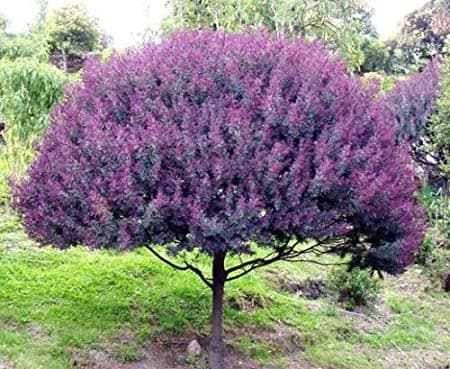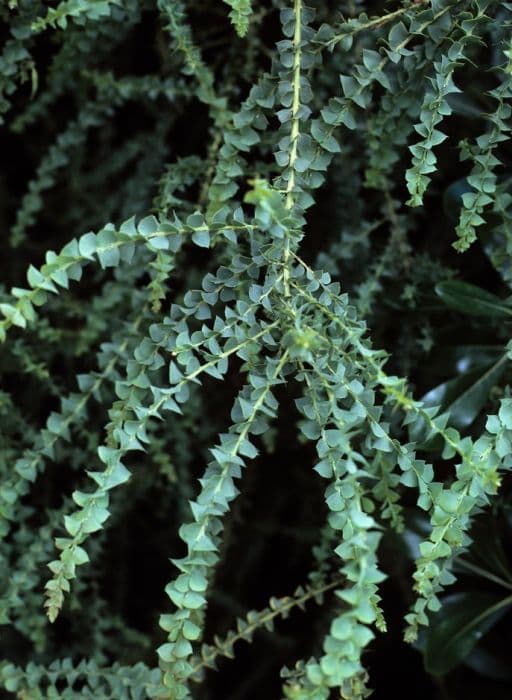Yoke-leaved Amicia Amicia zygomeris

ABOUT
Amicia zygomeris, often known as yoke-leaved amicia, is a unique and ornamental plant notable for its distinctive foliage and flowers. The leaves are a standout feature, with a bipinnate arrangement, meaning they are split into leaflets arranged on either side of a common axis. Each leaf has a pair of large, round, purple-tinged stipules at the base, which can sometimes be mistaken for flowers due to their eye-catching appearance. The true flowers of the yoke-leaved amicia are yellow pea-like blooms that cluster together in groups, adding a splash of color to the foliage. These flowers have a typical structure resembling those of the pea family, with a standard, wings, and keel, and they stand out against the green of the leaves. The stems of the plant are sturdy and often have a reddish tinge, complementing the green and purple of the leaves and creating a striking visual contrast. While the foliage retains its beauty throughout the growing season, the peak blooming period for yoke-leaved amicia flowers occurs in the late summer to early fall, providing a rich display of color at a time when many other plants may be starting to fade. The overall appearance of Amicia zygomeris is lush and vibrant, with an interesting mix of textures and colors that can make it an appealing addition to a garden setting or as a focal point in a landscape design.
About this plant
 Names
NamesSynonyms
Amicia, Yoke-leaved Amicia, Glyphosate-Resistant Amicia.
Common names
Amicia zygomeris.
 Toxicity
ToxicityTo humans
There is limited information available on the toxicity of Amicia zygomeris, commonly known as Yoke-leaved Amicia, to humans. It is not commonly listed as a toxic plant, suggesting that it may not have significant toxic properties. However, with any plant, some individuals might be sensitive and could potentially experience mild irritation of the skin, mouth, or stomach if parts of the plant are ingested or handled. As with many plants, it is advisable to avoid ingestion and to keep the plant away from small children who might inadvertently consume it.
To pets
Similar to its effects on humans, there is limited information regarding the toxicity of Yoke-leaved Amicia or Amicia zygomeris to pets. It does not appear on commonly referenced lists of toxic plants for animals such as dogs and cats. Nonetheless, ingestion of non-food plants can sometimes lead to gastrointestinal upset in pets, such as vomiting or diarrhea. Therefore, while specific toxicity symptoms are not widely reported for this plant, as a precaution, it is still wise to prevent pets from ingesting it. If a pet does consume Yoke-leaved Amicia, and you notice any signs of illness, it would be prudent to consult with a veterinarian.
 Characteristics
CharacteristicsLife cycle
Perennials
Foliage type
Deciduous
Color of leaves
Green
Flower color
Purple
Height
4-5 feet (1.2-1.5 meters)
Spread
2-3 feet (0.6-0.9 meters)
Plant type
Shrub
Hardiness zones
7
Native area
Mexico
Benefits
 General Benefits
General Benefits- Ornamental Appeal: Amicia zygomeris, commonly known as yoke-leaved amicia, features unique foliage and structure that can enhance the visual interest of a garden or landscape.
- Attracts Pollinators: The flowers of yoke-leaved amicia attract bees and butterflies, which are beneficial for pollination of plants in the garden.
- Drought Tolerance: Once established, yoke-leaved amicia is relatively drought-tolerant, making it suitable for xeriscaping or gardens in arid regions.
- Low Maintenance: This plant generally requires minimal care once established, making it suitable for gardeners seeking low-maintenance plants.
- Seasonal Interest: With its distinctive foliage and attractive flowers, yoke-leaved amicia provides visual interest from late summer to autumn.
- Edible Parts: While not widely known for its edibility, some parts of yoke-leaved amicia may be edible, providing a potential food source.
- Companion Planting: Yoke-leaved amicia can be planted alongside other species to create diverse and supportive plant communities in the garden.
- Fast Growth: This plant is known for its relatively fast growth rate, allowing gardeners to quickly establish a lush garden presence.
- Cultural Significance: In its native regions or among plant enthusiasts, yoke-leaved amicia may hold cultural significance or be part of traditional gardening practices.
- Teaching Tool: Due to its unique botanical features, yoke-leaved amicia can be used as an educational tool in horticultural studies or nature programs.
 Medical Properties
Medical PropertiesThis plant is not used for medical purposes.
 Air-purifying Qualities
Air-purifying QualitiesThis plant is not specifically known for air purifying qualities.
 Other Uses
Other Uses- As a natural dye: Amicia zygomeris can be used to extract natural dyes for coloring fabrics or other materials, utilizing the various plant parts for a range of hues.
- Ornamental crafting: The peculiar foliage and the unique shape of its leaves make it a favorite for adding a distinct touch to dried floral arrangements or wreaths.
- Insect repellent: Certain compounds found in the plant may deter insects, making it a candidate for inclusion in natural insect repellent formulations.
- Garden architecture: The sturdy stems and unique geometry of Amicia zygomeris make it a structural plant ideal for adding form and contrast in garden design.
- Educational tool: The plant's distinct leaf joint (pulvinus) can be used for educational demonstrations about plant movement and reactions.
- Photography: Its unique appearance provides an intriguing subject for botanical photographers and plant enthusiasts looking to document unusual species.
- Eco-printing: Leaves can be used in eco-printing techniques to create interesting patterns on paper or textiles.
- Biological research: Amicia zygomeris may be studied for its unusual leaf morphology and pollination strategies, contributing to botanical knowledge.
- Nature-inspired design: Its distinctive shape and form can inspire designs in fields such as biomimicry, architecture, and functional objects.
- Traditional ceremonies: In some cultures, unique plants like Amicia zygomeris might be used as part of ceremonial or ritualistic decorations due to their distinctive appearance.
Interesting Facts
 Feng Shui
Feng ShuiThe plant Amicia zygomeris, also known as the Yoke-leaved Amicia, is not used in Feng Shui practice.
 Zodiac Sign Compitability
Zodiac Sign CompitabilityThe plant Amicia zygomeris, also known as the Yoke-leaved Amicia, is not used in astrology practice.
 Plant Symbolism
Plant Symbolism- Unique Beauty: Amicia zygomeris, also known as the Yoke-leaved Amicia, is noted for its striking appearance and unique foliage which symbolizes standing out and embracing one's individuality.
- Rarity: Given that it's not a commonly found plant, it represents rarity and uniqueness, suggesting the value of rare qualities or treasures in life.
- Adaptability: As a plant that can adapt to diverse growing conditions, the Yoke-leaved Amicia symbolizes flexibility and resilience in various environments.
- Nurturing: With its ability to grow in difficult conditions, it represents nurturing and support even when circumstances are tough.
 Water
WaterThe Yoke-leaved Amicia should be watered thoroughly, allowing the top inch of soil to dry out between waterings. On average, this might mean watering every 5 to 7 days during active growth periods in spring and summer, but less frequently in winter, perhaps every 10 to 14 days, depending on the indoor environment's humidity and temperature. Immersion or bottom watering is an efficient method to ensure the roots are adequately hydrated without waterlogging the plant. Use approximately one to two gallons of water each time depending on the size of the plant and container, ensuring you provide enough water until it runs freely from the drainage holes.
 Light
LightThe Yoke-leaved Amicia thrives in bright, indirect light. It should be placed in a location where it can receive plenty of light without being exposed to harsh, direct sunlight which can scorch the leaves. A spot near an east or west-facing window where it gets gentle morning or evening sun, complemented by ambient light during the day, would be ideal.
 Temperature
TemperatureThe Yoke-leaved Amicia prefers a temperature range of around 60 to 75 degrees Fahrenheit for optimal growth. The plant can tolerate a minimum temperature of 50 degrees Fahrenheit, but the maximum temperature should not exceed 80 degrees Fahrenheit to avoid heat stress. Maintaining a consistent temperature within this range will help ensure the health and vitality of the plant.
 Pruning
PruningPruning the Yoke-leaved Amicia encourages healthy growth and maintains a desirable shape. Light pruning can be done at any time to remove dead or damaged leaves. It’s best to perform more significant pruning in the early spring before new growth begins, which allows the plant to recover and put energy into new foliage. Pruning can take place every year or when the plant appears to be getting too large for its designated space.
 Cleaning
CleaningAs needed
 Soil
SoilFor the best growth of Amicia zygomeris, commonly known as the yoke-leaved amicia, use a rich, well-draining soil mix comprising loam, sand, and peat with excellent aeration. This plant prefers a slightly acidic to neutral pH range of 6.0 to 7.0.
 Repotting
RepottingAmicia zygomeris should be repotted every two to three years. It's best to repot yoke-leaved amicia in the springtime just before the growing season begins, allowing the plant to establish itself in fresh soil.
 Humidity & Misting
Humidity & MistingYoke-leaved amicia thrives in moderate to high humidity levels, ideally between 40-60%. Avoid placing the plant in very dry environments, as consistent humidity is beneficial for its growth.
 Suitable locations
Suitable locationsIndoor
For growing yoke-leaved amicia indoors, ensure bright, indirect light and humidity.
Outdoor
Plant yoke-leaved amicia in partial shade and protect from strong winds outdoors.
Hardiness zone
Yoke-leaved amicia is suitable for 8-11 USDA hardiness zones.
 Life cycle
Life cycleAmicia zygomeris, commonly known as Yoke-leaved Amicia, begins its life cycle as a seed, germinating in spring under favorable conditions of moisture and temperature. Upon germination, the seedling emerges and establishes itself, developing roots and foliage in its juvenile stage. As it matures, it grows distinctive heart-shaped leaves with purple stipules and erect stems. The flowering stage occurs in late summer or early fall, where it produces yellow pea-like flowers that are attractive to pollinators. Following pollination, the flowers develop into pods containing seeds, which eventually dry and release seeds to conclude the reproductive cycle. In colder climates, Yoke-leaved Amicia behaves as an herbaceous perennial, dying back to the ground during winter and re-sprouting from its root system the following spring.
 Propogation
PropogationPropogation time
Spring-Early Summer
Propogation: Amicia zygomeris, commonly known as the Yoke-leaved amicia, is a perennial plant that is frequently propagated by seed. The optimum time for sowing the seeds of Yoke-leaved amicia is in the spring after the danger of frost has passed. The favored method involves starting seeds indoors, using a seed starting mix, approximately 6 to 8 weeks before the last expected frost. Seeds should be sown at a shallow depth, no more than 1/4 inch (about 6 mm) deep, as they require light for germination. The soil temperature should be kept around 70 degrees Fahrenheit (21 degrees Celsius) for optimal germination. Seedlings usually emerge in 14 to 21 days and can be transplanted to their final location once they have developed a couple of true leaves and all risk of frost has passed. It is important to acclimate the young plants to outdoor conditions gradually through a process called hardening off before planting them outdoors.









